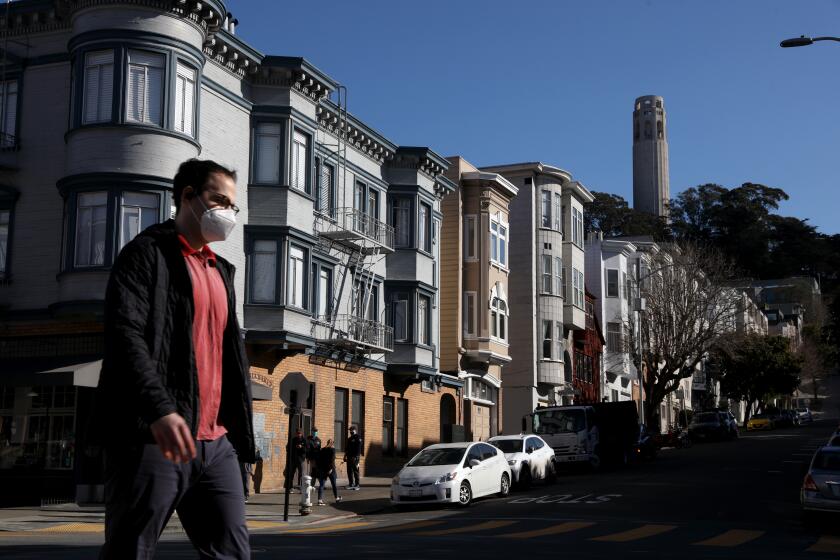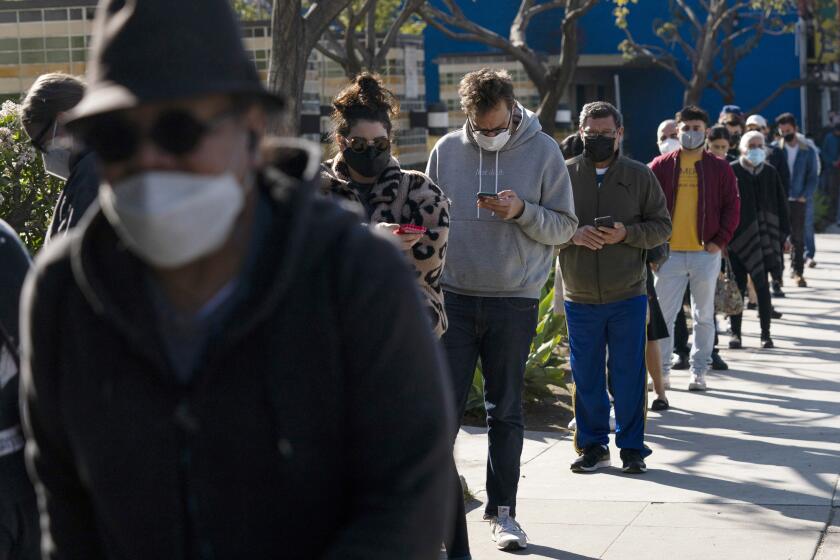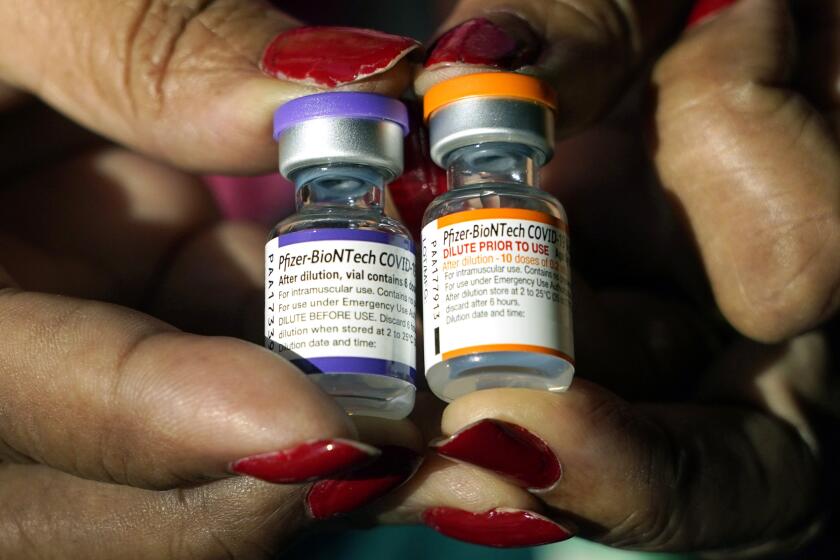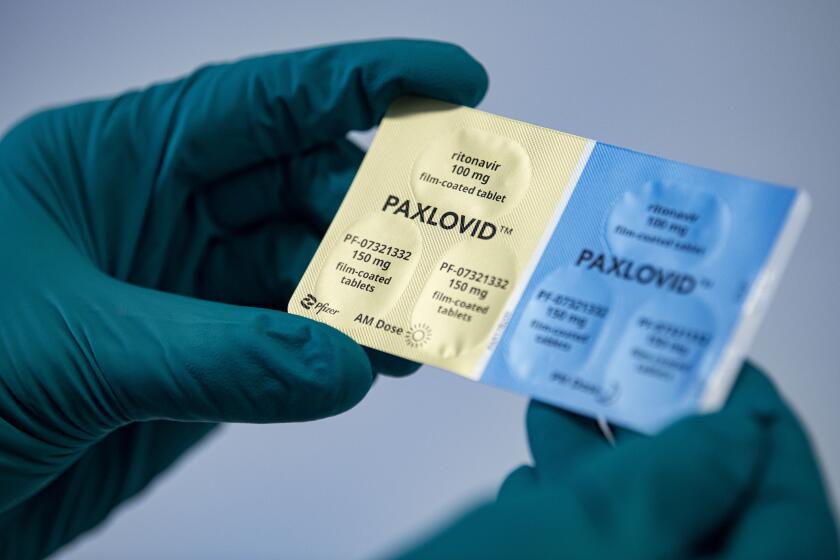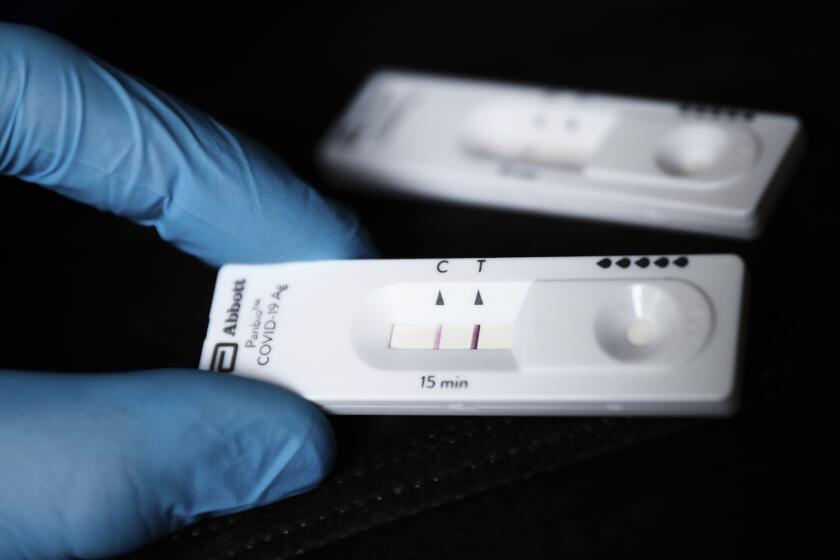With California hit by new coronavirus wave, time to start wearing masks? Limit gatherings?

- Share via
As California contends with another resurgence of the coronavirus, what should residents consider doing to protect themselves from infection?
Unlike in earlier waves of the pandemic that were marked by defined limitations on what people could do and how businesses could operate, officials have not demonstrated a broad appetite for renewed restrictions, unless hospitalizations dramatically worsen.
But it’s still important for residents to take action to reduce their infection risk, experts say — both to avoid potentially serious health consequences and reduce the chance of contracting long COVID, in which symptoms of illness, including fatigue and brain fog, can persist for months or years.
Los Angeles, Orange, Riverside and San Bernardino counties have all seen upticks in coronavirus case rates.
Here are what some experts had to say:
When should I wear a mask?
California lifted its statewide public indoor masking orders months ago. However, officials have consistently urged residents to use face coverings in public interior settings — including retail stores, restaurants, theaters and family entertainment centers.
The California Department of Public Health “also strongly recommends masks on all public transportation and in transit hubs, including bus and train stations, ferry terminals and airports,” according to a statement sent in response to an inquiry from The Times. “These crowded settings should be considered high risk and may often not have adequate ventilation.”
Los Angeles County has gone a step further and still requires face coverings on public transit, including ride-sharing vehicles, and in indoor transportation hubs.
“With all of the unknowns around these new variants, it is sensible to take the simple step of putting back on the mask when you’re indoors,” said Barbara Ferrer, the county’s public health director.
L.A. County also requires people who are close contacts of coronavirus-infected patients to wear a mask around others for 10 days after their last exposure. Close contacts are those who shared the same indoor space with someone with the coronavirus for at least 15 minutes over a 24-hour period while infectious.
Mask use also is required in L.A. County for coronavirus-infected workers who leave isolation relatively early and return to a physical workplace with co-workers. They can exit isolation as early as the sixth day after testing positive or becoming symptomatic — if they’ve since tested negative and aren’t sick — but they still need to wear a mask around other people until the 11th day.
The U.S. Centers for Disease Control and Prevention recommends indoor masking in counties where the COVID-19 community level is classified as high — meaning hospitals are starting to see strain from increasing numbers of coronavirus-positive patients.
No California counties are in that category. But regardless of a region’s level, “individuals may always choose to wear a mask to protect themselves from infection,” CDC Director Dr. Rochelle Walensky said last week.
Coronavirus infections have increased 63% statewide, bringing the case rate to 231 for every 100,000 California residents. Hospitalization rates are rising but remain low.
How about gatherings?
There are a few steps people can take if they’re going to attend or host a gathering.
Outdoors is preferable to indoors. If you must gather inside, make the setting as well-ventilated as possible by opening doors and windows, if possible. Wearing masks also offers an additional layer of protection, officials say.
“We’re not suggesting that people avoid gatherings, but we are suggesting that people gather with a lot of safety layered in,” Ferrer said during a recent briefing.
Testing is another tool. Officials recommend using rapid tests to check infection status as close to the start of a gathering as possible — especially if older people or those with underlying health conditions are present, or if attendees have frequent contact with vulnerable people.
“Please don’t be shy about telling people you’d like them to test” before a gathering, Ferrer said.
Another bummer coronavirus summer for California? With cases on the rise, the state finds itself in a familiar, if frustrating, position.
What about indoor dining?
Health experts have offered varying suggestions on indoor dining, given the high rate of viral transmission.
Dr. Robert Wachter, chair of UC San Francisco’s Department of Medicine, has tweeted that coronavirus case rates are far above his comfort level for dining in indoor restaurants. Wachter has said he’d be OK dining indoors if the case rate were no higher than 70 cases a week for every 100,000 residents; L.A. County’s rate is nearly four times as high, and San Francisco’s is more than six times his cutoff.
Dr. Peter Chin-Hong, a UC San Francisco infectious-disease expert, said in an interview Friday he’d still go into a well-ventilated indoor restaurant at this point, but he might avoid dining inside a stuffy hole-in-the-wall eatery.
Ferrer said she avoids eating in indoor places.
“There obviously are places where, even indoors, it’s less risky because there’s very good ventilation, there’s not a lot of people, you know all the people, everyone tested before they gathered,” Ferrer said. There are “no hard and fast rules here that apply to everyone,” she added, “but being cautious is definitely the name of the game for anybody who’s at elevated risk.”
Boosters
Residents looking to stave off the worst health impacts of COVID-19, officials say, should also get vaccinated if they haven’t already — and get a first and/or second booster when eligible.
“Vaccination remains a critical element of the COVID-19 response,” the California Department of Public Health wrote in its statement. “COVID-19 vaccines are particularly effective at preventing severe disease. CDPH urges all eligible persons to be vaccinated and boosted.”
Residents who are at least 50 years old, as well as those 12 and older who are immunocompromised, became eligible in March for a second booster four months after their first.
“That not only protects you from going to the hospital, but I think that the government’s approach this time is to top off everybody’s antibodies as much as possible, so that you don’t transmit the infection as efficiently,” Chin-Hong said.
The CDC now recommends those 50 and older, and immunocompromised people 12 and older, get that second booster shot.
“Most older Americans received their last dose (either their primary series or their first booster dose) many months ago, leaving many who are vulnerable without the protection they may need to prevent severe disease, hospitalization, and death,” the agency said in a statement.
Booster doses are also now available for children ages 5 to 11.
“Whether it is your first booster or your second, if you haven’t had a vaccine dose since the beginning of December 2021 and you are eligible, now is the time to get one,” the CDC said in a statement.
The news comes after months of anxious waiting by parents desperate to vaccinate their babies, toddlers and preschoolers.
Treatment
Chin-Hong said more vulnerable people can reduce their risk by having a plan to get Paxlovid — an antiviral drug that treats COVID-19 — should they become infected.
Paxlovid, a five-day course of pills manufactured by Pfizer, needs to be taken within a few days of symptom onset. It reduces the risk of hospitalization or death from COVID-19 by 89% among higher-risk adults who haven’t been hospitalized.
“Many people eligible should just take it. Because it’s not only good to help them to stay away from the hospital, but it’s good for transmission. ... We know that viral load drops quicker once you’re on Paxlovid,” Chin-Hong said.
Having a Paxlovid plan, Chin-Hong continued, “means knowing who’s going to write you this prescription, where you’re going to likely get it — because not all drugstores have it.”
Health experts are urging people to be cautious if they develop symptoms again after taking anti-COVID pills.
Chin-Hong also recommended consulting with a healthcare provider to ensure that Paxlovid won’t pose problems with other medications, “so you don’t have to go scrambling” once you test positive for the virus.
There is no longer a shortage of Paxlovid, and the eligibility criteria to get the drug are fairly wide. Factors that could make a patient eligible include having high blood pressure, a heart condition, asthma or diabetes; being overweight; being physically inactive; being a current or former smoker; or having depression, anxiety or a fear-related disorder.
The U.S. government has a website displaying which pharmacies have anti-COVID drugs.
Older people who have a “Paxlovid plan, up their mask game in crowded indoor settings, and get up to date on vaccines — there’s no reason why you can’t be reasonable and go out and about,” Chin-Hong said.
The Biden administration announced Tuesday that each U.S. household can order eight free at-home test kits, on top of the eight previously made available.
Are additional restrictions possible?
Though officials stress it’s impossible to know the future, they’ve so far indicated that a return to COVID-19 restrictions on businesses and activities is not in the cards at this point.
Statewide, the California Department of Public Health has not set any specific benchmarks that would see the reimposition of restrictions.
“As we have learned throughout the pandemic, each surge and each variant brings with it unique characteristics relative to our neighborhoods and communities specific conditions (e.g., level of immunity),” the department wrote in its statement Monday. “Therefore, instead of laying out specific thresholds or triggers, California will continue to evaluate the data quickly and nimbly to determine how to best handle future changes in the behavior of the virus.”
One possible area of change is public transit, as the legal fate of a federal mask mandate in those settings remains up in the air.
“We continue to monitor federal action on the issue of public transit and will announce any additional changes to state policies as needed,” the state department of public health said.
The latest maps and charts on the spread of COVID-19 in Los Angeles County, including cases, deaths, closures and restrictions.
In L.A. County, officials have said they would reinstitute a universal public indoor mask mandate should the region shift into the CDC’s high COVID-19 community level.
“To avoid moving to the high community level, which signifies very high transmission and stress on the healthcare system, residents, workers and businesses need to not shy away from reinstating or adhering to safety practices that are known to reduce transmission,” Ferrer said. “This includes indoor masking; testing when people are sick, exposed or gathering; and staying up to date on vaccinations.”
More to Read
Sign up for Essential California
The most important California stories and recommendations in your inbox every morning.
You may occasionally receive promotional content from the Los Angeles Times.
